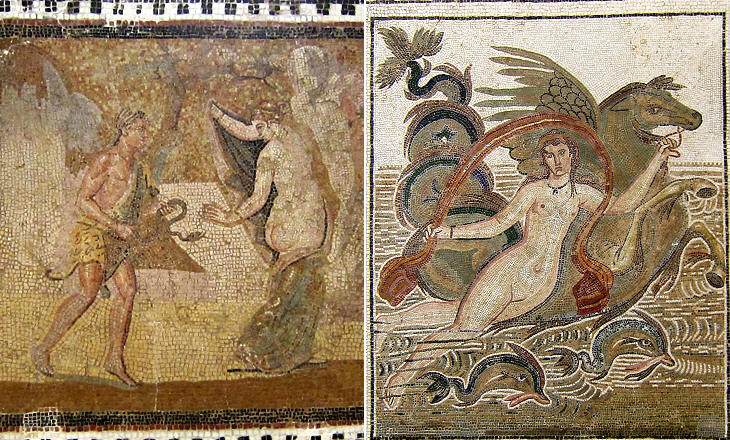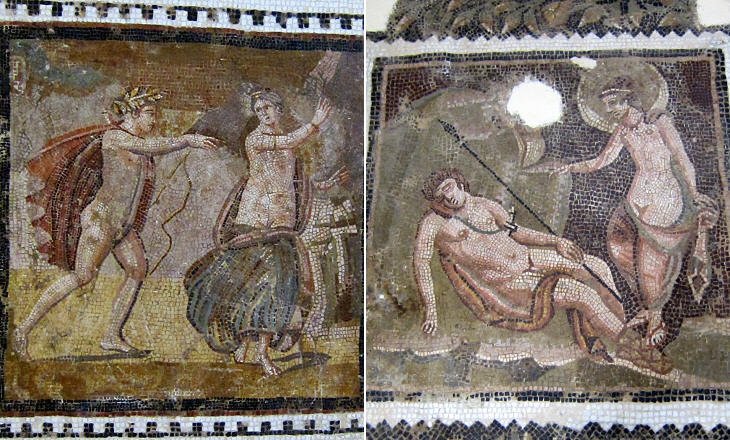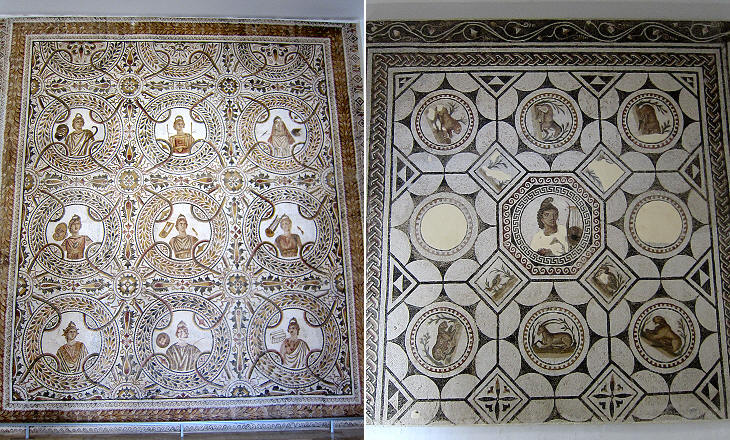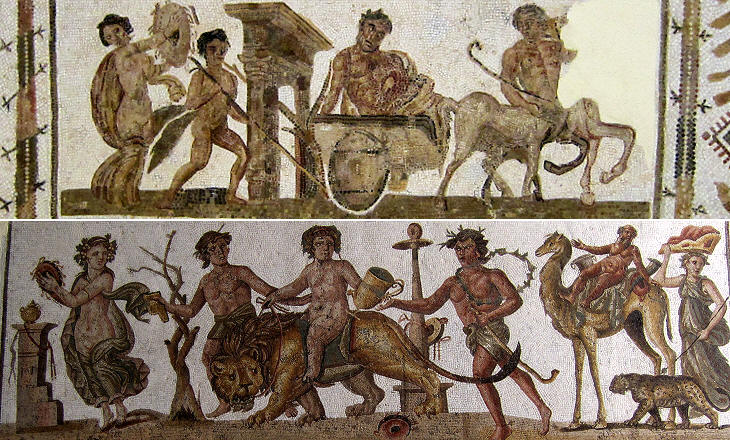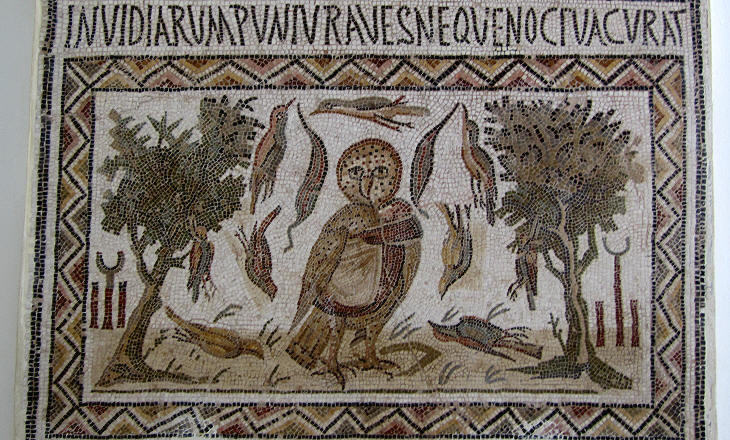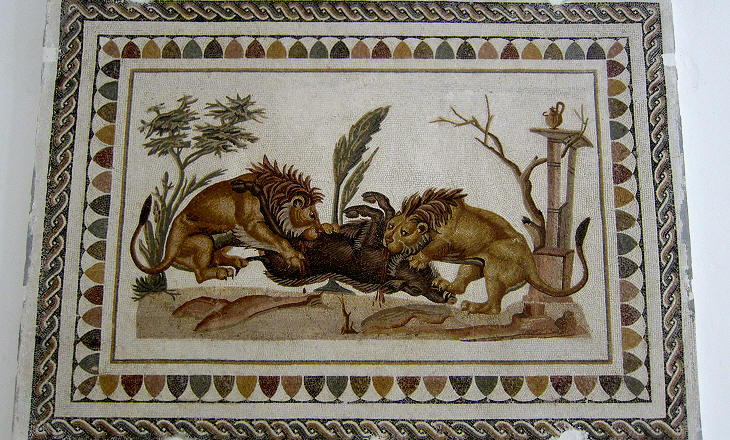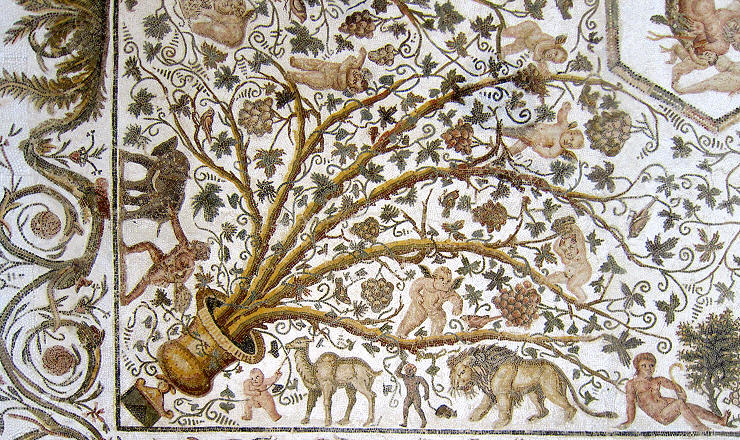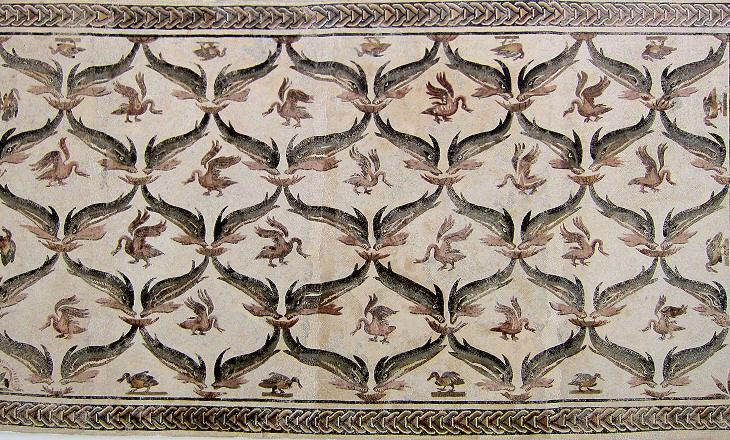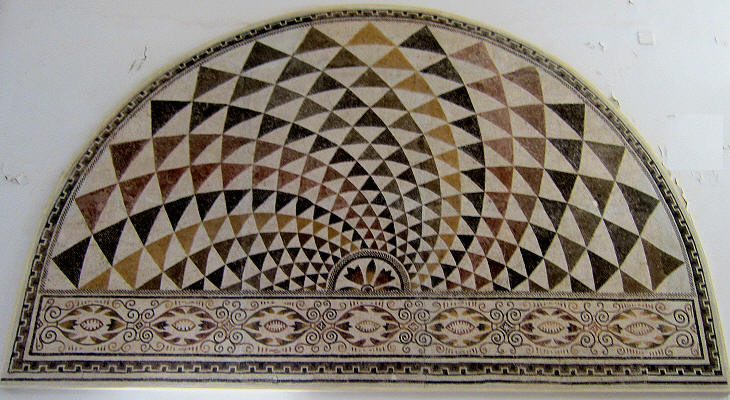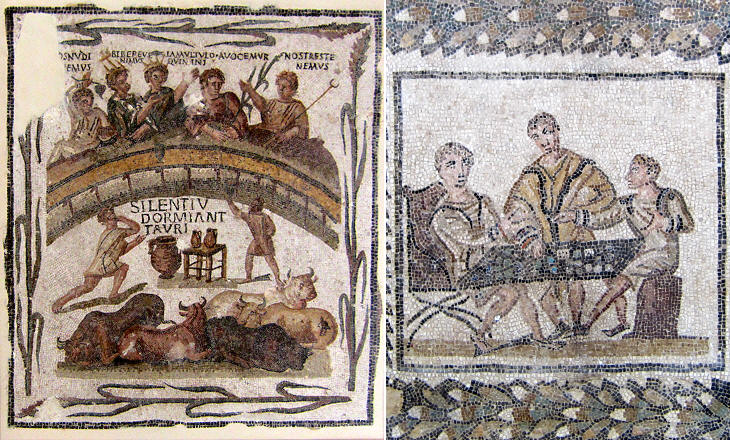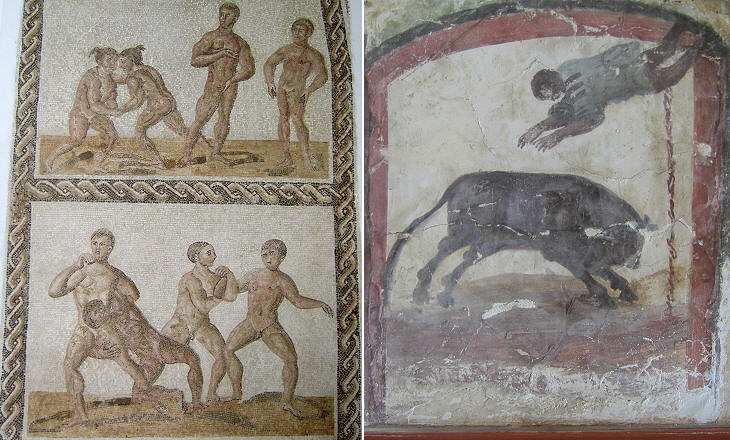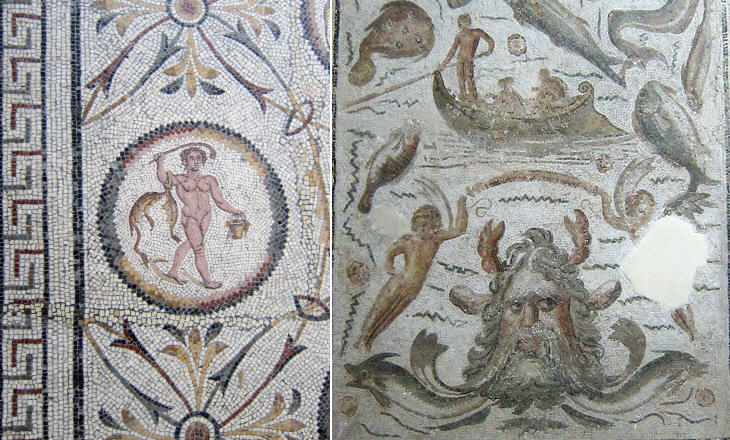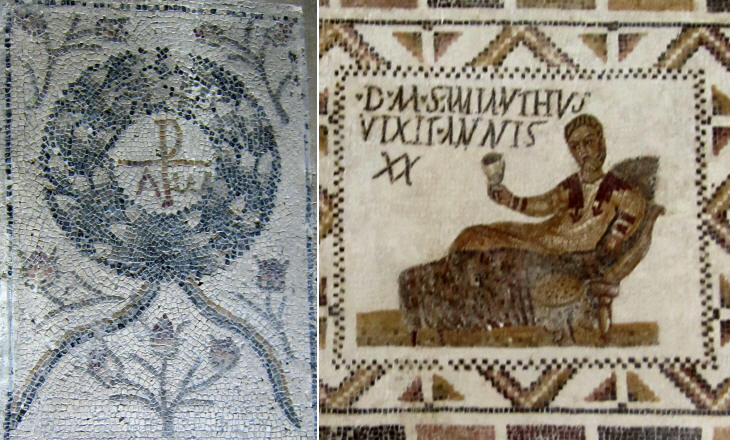  What's New! Detailed Sitemap All images © by Roberto Piperno, owner of the domain. Write to romapip@quipo.it. Text edited by Rosamie Moore. Page added in September 2012. |
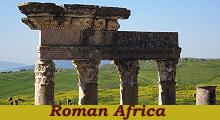 - Thysdrus (El Djem): the Museum - Thysdrus (El Djem): the Museum(temple at Thugga) The Archaeological Museum of El-Djem, the ancient Thysdrus which is best known for its amphitheatre, houses a series of mosaics found in the environs of the town. It is a modern museum where the exhibits are displayed in a very effective way.
The most elaborate mosaics were reserved to the triclinia, the formal dining rooms of the Romans. The name means three couches because the diners ate their meals reclining on couches or cushions placed on three sides of the room, forming a sort of U-shape table. A typical mosaic for a Roman triclinium had a small pictorial section (emblema) at its centre which the diners could admire during the meal. This section was made by a different person than that who took care of the decorative frame.
Apollo was not invariably successful in love. On one occasion he pursued Daphne, a mountain nymph and a priestess of Mother Earth; but when he overtook her, she cried out to Mother Earth who, in the nick of time, spirited her away to Crete and left a laurel-tree in her place, and from its leaves Apollo made a wreath to console himself. Endymion was lying asleep in a cave one still night when Selene first saw him, lay down by his side, and gently kissed his closed eyes. Afterwards he fell into a dreamless sleep, because Selene found that she preferred gently kissing him to being the object of his too fertile passion. He has never grown a day older, and preserves the bloom of youth on his cheeks. From Robert Graves - The Greek Myths.
The Romans did not have much furniture in their rooms and a decorative mosaic helped in avoiding a feeling of emptiness. In the above mosaics the emblema was multiplied by nine to increase its "filling" effect. The images were usually placed inside medallions; in some instances, as in the mosaic of the Muses, all images had the same orientation and they probably faced the room entrance, in other cases the orientations were different or converged towards the central image.
The Four Seasons distributed around a central image were a very popular subject to create a mosaic with five focal points. Ganymedes was the most beautiful youth alive and therefore chosen by the gods to be their cup-bearer. It is said that Zeus, desiring Ganymedes also as his bedfellow, disguised himself in eagle's feathers and abducted him. According to the most usual account Zeus companioned with Leda in the form of a swan. She laid an egg from which were hatched Helen, Castor and Polydeuces. From Robert Graves - The Greek Myths.
Movies and TV serials have made two aspects of Roman life very popular: gladiatorial fights and indiscriminate sexual activity. Many mosaics found throughout the Roman Empire and portraying Dionysus surrounded by satyrs and maenads may have contributed to the latter. The meaning of these mosaics was rather complex and not limited to sexual aspects. The sound of the tambourines chased evil spirits away. Playing music, drinking and laughing were ways by which the ancient Greek and Romans faced the fact that Yet we mortals bear per-force what the gods send us, though we be grieved; for a yoke is set upon our necks. Hymn to Demeter - translated by Hugh G. Evelyn-White.
I rather think that the emotion of jealousy is by far the fiercest of all, and needs as much energy for its repression as for its stimulation. Now people are especially jealous of their equals, or of those once beneath them, when they feel themselves left behind and fret at the others' upward flight. Cicero - De Oratore - Book II - 209 - Translation by E. W. Sutton. Evil spirits could take the form of envious thoughts and this mosaic was meant to protect the house from them.
The making of an elaborate mosaic required teamwork. Calcis coctor was in charge of preparing the mortar, the quality of which was key to ensure the duration of the mosaic. Pavimentarius prepared the floor by laying the lower layers of the mosaic. Tessellarius made the simpler parts of the mosaic such as geometric frames. Pictor musivarius executed the most elaborate sections based on drawings made by Pictor imaginarius. These last two activities were often combined.
This jar was a symbol of Dionysus. It was usually depicted with a grapevine growing from it, as in some Roman baths along Via Appia. It was adopted by the early Christians as a symbol of life with apple trees replacing grapevines as in the mosaic in the Baptistery of Bellator at Sufetula. A similar mosaic can be seen at S. Costanza in Rome.
Almost all of the mosaics in the museum hang on the walls, something which in some cases make them resemble tapestries. The choice of dolphins and swans was not dictated only by aesthetic aspects because the two animals were both sacred to Apollo. When Leto bore Apollo on the then floating island of Delos, swans surrounded her to hide the delivery from Hera. Apollo sent dolphins to rescue Arion, a famous lyre player who, before throwing himself into the sea from a pirates' ship, sang a song of praise to the god.
This very decorative mosaic depicting peacock feathers has a link to Greek myths. Io was a priestess of Hera and Zeus fell in love with her. When Hera charged him with infidelity he turned Io into a white cow, which Hera claimed as hers and handed over to Argus Panoptes, a giant with one hundred eyes. Zeus sent Hermes to steal Io. Hermes crushed Argus with a boulder after having made him fall asleep by playing the flute. Hera placed Argus' eyes in the tail of a peacock. From Robert Graves - The Greek Myths. The eyes on the peacock feathers had the power of detecting and chasing evil spirits.
Decorative mosaics eventually developed patterns which were entirely meant to obtain an aesthetic effect with no links to real things or mythical personages. In essence it was an early form of abstract art. You may wish to see an almost identical mosaic at Dion where it was part of a frame. MUSEUM OF BARDO
The first mosaics found at Thysdrus were moved to the Museum of Bardo in Tunis. The mosaics above show moments of relaxation at the amphitheatre or playing dice. The sentence of the first one means "let sleeping dogs lie". Roman law prohibited dice playing outside the week of Saturnalia (December 17-23), but the game was very popular and Emperor Augustus is said to have been addicted to it. Six was the score of Venus, one that of the dog. MUSEUM OF SFAX
Sfax is the second largest city of Tunisia. It is situated on the coast some forty miles south of El-Djem. Its Archaeological Museum is housed in some rooms of the Town Hall, which are at present (2012) unfit for appropriately displaying their exhibits which mainly come from Thaenae, a nearby Roman town.
In addition to mosaics with typical subjects, the Museum of Sfax houses some interesting examples of Christian mosaics which decorated tombs.
The image in the background of this page shows a decorative mosaic in the Museum of El-Djem. The pattern is based on peltas, the shields of the Amazons. Return to page one and see the amphitheatre. Move to: Introductory Page Bulla Regia Carthago Mactaris Musti Neapolis Sicca Veneria Simitthus Sufetula Thuburbo Majus Thugga Uthina Utica Ziqua Mosaics in the Museum of Bardo  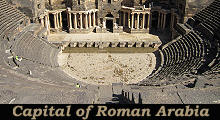 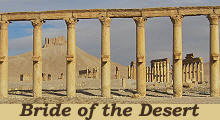 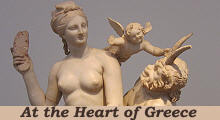
|
